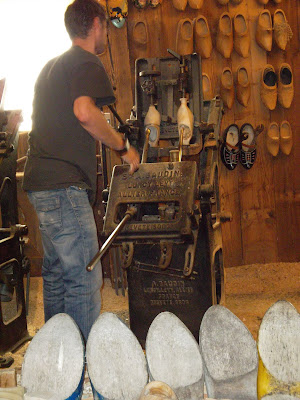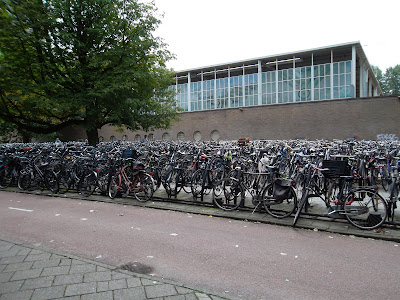 |
| Typical Zaanse Schans House |
As soon as you step off the bus in Zaanse Schans, you know you're in a special place -- the aroma of chocolate teases your nostrils and points you in the direction of the bridge over the River Zaan, next to the Verkade chocolate and biscuit factory. Once over the bridge, you find yourself in a village of green-painted gingerbread houses (could this be the origin of the American Carpenter Gothic architectural style?), workshops, and two-hundred-year-old windmills that still saw wood, grind grain, and press paint pigments. The windmills were moved here from all over the Zaan region about 50 years ago, creating an open-air museum visited by hundreds of thousands of tourists every year.
According to "The Dutch I Presume," the Zaanstreek (Zaan region) was the oldest industrial region in the world. The first sawmills were built in this area at the end of the 16th century, producing lumber for the shipping industry. The Zaanstreek shipyards became so famous that Czar Peter the Great of Russia came to this area in 1697 to learn about Western methods of shipbuilding.
 |
| First Albert Heijn Grocery Store |
Near the first Albert Heijn grocery store (which developed into a nationwide chain of supermarkets), you can also see a demonstration of pewter artisanry, baking, and cheese-making. One of the highlights of the village is the klompenmakkerij (clog-making demonstration). Years ago, wooden shoes were carved laboriously by hand, which took the better part of a day to produce a finished pair. Today they are made in a matter of minutes by machine.
The wood most often used is poplar, with a water content of 60 percent, which makes the wood soft enough to work with easily. The shoe on the left is used as a pattern for carving out the block on the right. Once the shoes are carved, they are let to air dry before being painted. Exhibits showed a great variety of styles: clogs for walking on peat or ice, brightly painted clogs for Sunday best, intricately carved wedding clogs, and even a pair of clogs for horses.
 |
| "Sunday clogs" |
After viewing the exhibits and watching the demonstration, it was difficult to resist the temptation to take home a pair:
 |
| Do they have my size? |
To the average tourist, a windmill is a windmill. But there is a whole science to learn about how the mechanisms function, how to prevent the wind from blowing them apart, and even how to turn the top section of the mill to face the wind. The traditional mills have names; one we visited was used to grind various materials for paint pigment, including the green paint traditionally used to paint houses in Zaandam. This iconic mill is called De Kat (The Cat).
 |
| De Kat, Zaanse Schans |
(Many thanks to cousin Robbertjan for being our guide at Zaanse Schans. I last visited this spot many years ago with Robbertjan's grandfather, Jasper Daams. Perhaps some old photos from that trip may turn up one of these days, to be added to this post!)














































